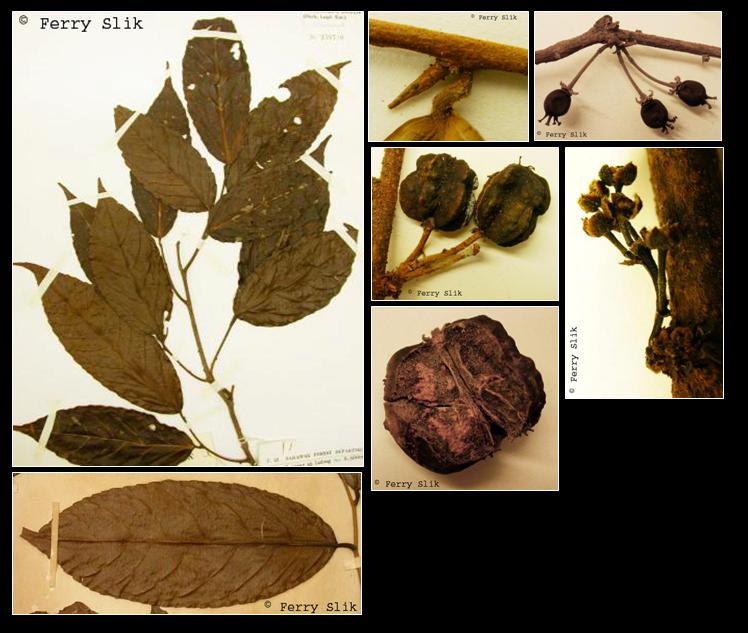Flacourtia rukam Zoll. & Mor., in Mor. Syst. Verz. (1846)
Latin for the local name of this species.Synonyms
Flacourtia cataphracta Blume [Illegitimate]
Flacourtia edulis Griff.
Flacourtia euphlebia Merr.
Flacourtia megaphylla Ridl.
Flacourtia peninsula Elm.
Flacourtia rukam var. domestica Ridl.
Flacourtia rukam var. erythrocarpa Ridl.
Flacourtia rukam var. micronesica Fosberg & Sachet
Flacourtia rukam var. myriantha Merr.
Flacourtia sulcata Elm.
Hisingera grandifolia Turcz.
Diagnostics
Small tree, 5!15(!20) m tall; trunk and old branches usually crooked, furrowed, branched near
the base; young stem and branches with strong, woody, simple or branched spines, up to 10 cm long.
Leaves alternate, often shiny dark green above, brownish-red and drooping when young, margins
coarsely toothed; petiole 5!8 mm long. Inflorescences few-flowered racemes; flowers
greenish-yellow, sepals 4, petals absent; male flowers with 8 orange or yellow-white fleshy
disk-lobes and numerous stamens; female flowers usually without stamens, styles 4!6(!8),
Fruit a globose berry, 2!2.5 cm in diameter, light-green to pink or purplish-green to dark red.
Description
Small tree, 5-15(-20) m tall; trunk and old branches usually crooked, furrowed, branched near the base; young stem and branches with strong,
woody, simple or branched spines, up to 10 cm long, usually absent in clonally propagated trees. Leaves ovate-oblong or elliptic to
oblong-lanceolate, (6.5-)10-15(-18) cm x (3-)4-7(-9) cm, glabrous or puberulous on midrib and nerves, often shiny dark green above,
brownish-red and drooping when young, margins coarsely toothed; petiole 5-8 mm long. Inflorescences in few-flowered, short, axillary,
finely pubescent racemes; pedicels 3-4 mm long; flowers greenish-yellow, usually unisexual; sepals 4, rarely 3-6, petals absent; male flowers
with 8 orange or yellow-white fleshy disk-lobes and numerous stamens; female flowers usually without stamens, styles 4-6(-8), free, stigmas
indistinctly bilobed. Fruit a globose, depressed-globose to obovate berry, 2-2.5 cm in diameter, light-green to pink or purplish-green to dark
red with whitish, juicy, acid pulp, crowned by the 4-6(-8) small peg-like styles set in a circle. Seeds 4-7, flat. [from PROSEA]
Ecology
In slightly disturbed mixed dipterocarp, keranga, peat-swamp and sub-montane
forests up to 1200 m altitude. Common on alluvial swampy sites and riversides as
well as dry hillsides and ridges. Mostly on poor shallow sandy soils and
limestone.
Uses
The ripe fruit can be eaten raw; it is rubbed between the palms of the hand because bruising the flesh eliminates astringency.
It is also served in 'rujak', a fruit salad with spicy sauce, pickled, or sweetened with sugar to make jam or confectionaries.
The young leaves are eaten raw in side dishes. Immature fruit is used to prepare traditional medicine against diarrhoea and dysentery.
The juice of the leaves is applied to inflamed eye-lids. In the Philippines a root decoction is taken by women after childbirth.
The wood is hard and strong and used to make household utensils such as pestles and furniture.
Distribution
Rukam is widely distributed but scattered, both cultivated and wild, all over Malesia. It is apparently rare in the Moluccas and in New Guinea.
It has been introduced in Indo-China, India and Thailand.
Local names
English: Rukam.
French: Prunier de Chine, prunier cafe.
Indonesia: ganda rukem, rukam (Java), klang tatah kutang, Rokam, Rukam, Tepetatah (Borneo).
Laos: ken.
Malaysia: rukam manis, rukam gajah.
Philippines: amaiit (Tagalog), aganas (Bisaya), kalominga (Igorot).
Thailand: takhop-thai (central), khrop-dong (Pattani).
Vietnam: mung guan ru'ng.
